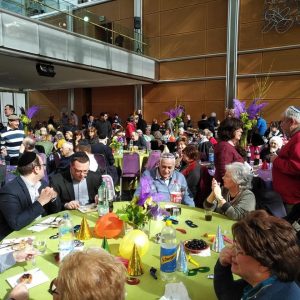
In conversation with Adrian Cohen, who is our guest blogger chatting about Purim.
Adrian is along standing friend of the chaplaincy and used to be a Partner at Clifford Chance in Canary Wharf before he moved to be a Partner at Proskauer the City.
We are grateful to Adrian for contributing to the Chaplaincy blogs.
The Jewish calendar is replete with many religious holidays, some solemn, others less so, all with their own rules, customs and traditions. Judaism is a very performative and communal religion.
Purim is the one most identified with fun with a licence to indulge in raucous behaviour. It is often dubbed the Jewish Mardi Gras. Customs include wearing fancy dress, face masks and feasting. Other customs include giving gifts to friends and donations to the poor.
The festival concerns the events detailed in the Book of Esther which forms part of the biblical canon. Historically these events are thought to have taken place around the 5th century BCE in the period between the destruction of the First Temple in Jerusalem and the return of the Jews to Judea and the rebuilding of the Temple. The Persian Empire was the then dominant power across the near and Middle East and most of the Jewish population lived within its dominion.
The story involves the confounding of the plot by Haman, the Royal Vizier to the King of Persia Ahasuerus (derived from the old Persian for Xerxes or Artaxerxes) to have all the Jews exterminated on a date corresponding with the Hebrew date of 14th Adar. The date is chosen by the drawing of lots and hence the name Purim meaning lots. He is outmanoeuvred by a sage and leader by the name of Mordechai, descended from the tribe of Benjamin, and his nice Esther who is married to the King. Haman ends up being hanged on the gallows he had built for Mordechai and his ten sons meet a similar fate. The Jews are able to defend themselves and take retribution against their wider foes.
The festival best meets the paradigm of ‘they tried to destroy us, they failed, let’s eat’. It was reported by the press when notorious Nazi Julius Streicher went to the gallows at Nuremberg in 1946 that he shouted out ‘Purim Fest!’ meaning Purim Feast implying he had been defeated in a way similar to Haman.
Jews are required to hear the Book of Esther in two public readings from a parchment scroll. Pre covid thanks to the efforts of the estate manager Danny Seliger there used to be for many years a large Purim party in the East Winter Garden attended by a mix of people working in the estate and the elderly of the community and their helpers.
For me Purim is an important part of my heritage. It provides a psychological need, an opportunity to let off steam as the long winter draws to a close but it also serves as a reminder of the fragility of diaspora existence that makes up so much of Jewish history.
Curiously G-d isn’t mentioned in the Book of Esther and as the name of the festival suggests everything seems to happen by luck or happenstance and yet Mordechai and Esther are deeply pious people. Esther’s name is derived from the Hebrew word for hidden. The whole festival concerns the hidden, we disguise ourselves in funny clothes and masks. G-d is there throughout but we can’t see it. Sometimes He hides his face from us and seemingly leaves us to our fate at the hands of our enemies and yet there is another chapter and another tomorrow. It teaches us that we cannot sit back and rely on Divine intervention. Instead it teaches us that we should take action guided by and informed by our faith as best as we can accepting our fallibility as humans.






